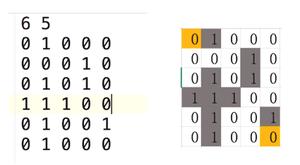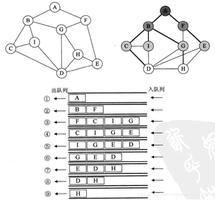C语言实现图的遍历之深度优先搜索实例
DFS(Depth-First-Search)深度优先搜索算法是图的遍历算法中非常常见的一类算法。分享给大家供大家参考。具体方法如下:
#include <iostream>
#include <algorithm>
#include <iterator>
using namespace std;
#define MAX_VERTEX_NUM 10
struct Node
{
int adjvex;
struct Node *next;
int info;
};
typedef struct VNode
{
char data;
Node *first;
}VNode, AdjList[MAX_VERTEX_NUM];
struct Graph
{
AdjList vertices;
int vexnum, arcnum;
};
int visited[MAX_VERTEX_NUM];
int locateVex(Graph G, char u)
{
int i;
for (i = 0; i < G.vexnum; i++)
{
if (u == G.vertices[i].data)
return i;
}
if (i == G.vexnum)
{
printf("Error u!\n");
exit(1);
}
return 0;
}
void createGraph(Graph &G)
{
int i, j, k, w;
char v1, v2, enter;
Node *p;
printf("input vexnum & arcnum:\n");
scanf("%d", &G.vexnum);
scanf("%d", &G.arcnum);
printf("input vertices:\n");
for (i = 0; i < G.vexnum; i++)
{
scanf("%c%c", &enter, &G.vertices[i].data);
G.vertices[i].first = NULL;
}
printf("input Arcs(v1, v2, w):\n");
for (k = 0; k < G.arcnum; k++)
{
scanf("%c%c", &enter, &v1);
scanf("%c%c", &enter, &v2);
scanf("%d", &w);
i = locateVex(G, v1);
j = locateVex(G, v2);
p = (Node *)malloc(sizeof(Node));
p->adjvex = j;
p->info = w;
p->next = G.vertices[i].first;
G.vertices[i].first = p;
}
}
void DFS(Graph &G, int v)
{
Node *p;
printf("%c", G.vertices[v].data);
visited[v] = 1;
p = G.vertices[v].first;
while (p)
{
if (!visited[p->adjvex])
DFS(G, p->adjvex);
p = p->next;
}
}
void DFSTranverse(Graph &G)
{
for (int v = 0; v < G.vexnum; v++)
visited[v] = 0;
for (int v = 0; v < G.vexnum; v++)
{
if (!visited[v])
DFS(G, v);
}
}
int main()
{
Graph G;
createGraph(G);
DFSTranverse(G);
}
再换一种方式来写DFS。具体代码如下:
#include <iostream>
#include <string>
using namespace std;
#define MAXLEN 10
struct Node
{
int data;
Node *next;
};
struct Link
{
int count;
string name;
Node *head;
};
struct Graph
{
Link link[MAXLEN];
int vexnum;
int arcnum;
};
int findIndex(Graph &G, string name)
{
int index = -1;
for (int i = 0; i < G.vexnum; i++)
{
if (G.link[i].name == name)
{
index = i;
break;
}
}
if (index == -1)
cout << "error" << endl;
return index;
}
void constructGraph(Graph &G)
{
cout << "construct graph yooo" << endl;
cout << "enter vexnum" << endl;
cin >> G.vexnum;
string array[] = {"v1", "v2", "v3", "v4", "v5", "v6", "v7", "v8"};
const int size = sizeof array / sizeof *array;
for (int i = 0; i < G.vexnum; i++)
{
G.link[i].name = array[i];
G.link[i].head = NULL;
}
string leftName;
string rightName;
cout << "enter a pair" << endl;
cin >> leftName >> rightName;
while (leftName != "end" && rightName != "end")
{
int leftIndex = findIndex(G, leftName);
int rightIndex = findIndex(G, rightName);
Node *node = new Node;
node->data = rightIndex;
node->next = NULL;
node->next = G.link[leftIndex].head;
G.link[leftIndex].head = node;
cout << "enter a pair" << endl;
cin >> leftName >> rightName;
}
}
bool flag[MAXLEN];
void DFSTranverse(Graph &G, int num)
{
cout << G.link[num].name << " ";
flag[num] = true;
Node *head = G.link[num].head;
while (head != NULL)
{
int index = head->data;
if (!flag[index])
DFSTranverse(G, index);
head = head->next;
}
}
void main()
{
Graph G;
constructGraph(G);
for (int i = 0; i < MAXLEN; i++)
flag[i] = false;
DFSTranverse(G, 0);
}
DFS的迭代遍历算法如下:
void DFS(Graph &G)
{
stack<int> istack;
istack.push(0);
cout << G.link[0].name << " ";
flag[0] = true;
while (!istack.empty())
{
int index = istack.top();
Node *head = G.link[index].head;
while (head != NULL && flag[head->data] == true)
head = head->next;
if (head != NULL)
{
index = head->data;
if (!flag[index])
{
cout << G.link[index].name << " ";
flag[index] = true;
istack.push(index);
}
}
else
istack.pop();
}
}
感性的朋友可以测试运行一下本文实例代码以加深印象,相信本文所述对大家C程序算法设计的有一定的借鉴价值。
以上是 C语言实现图的遍历之深度优先搜索实例 的全部内容, 来源链接: utcz.com/z/321164.html








